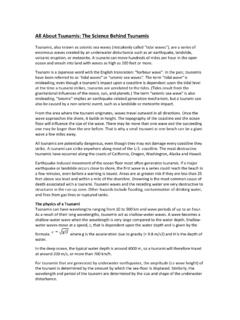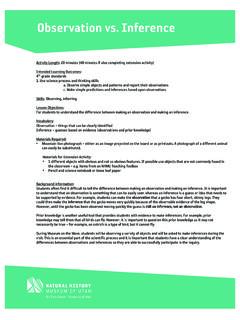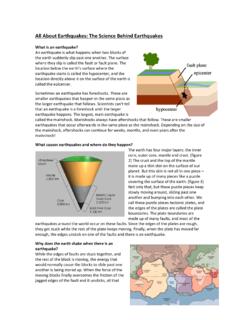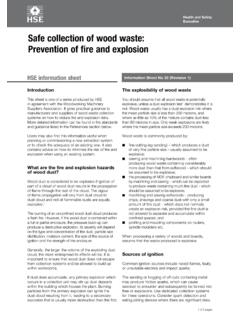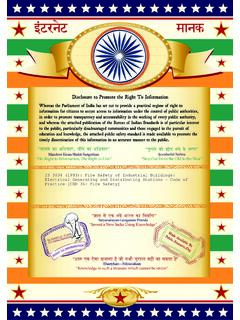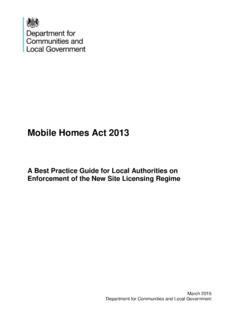Transcription of All About Wildfires: The Science Behind Wildfires
1 All About Wildfires : The Science Behind Wildfires A wildfire is an uncontrolled fire in an area of combustible vegetation that occurs in the countryside or a wilderness area. Other names such as brush fire , bushfire, forest fire , desert fire , grass fire , hill fire , peat fire , vegetation fire , and veldfire may be used to describe the same phenomenon depending on the type of vegetation being burned. A wildfire differs from other fires by its extensive size, the speed at which it can spread out from its original source, its potential to change direction unexpectedly, and its ability to jump gaps such as roads, rivers and fire breaks.
2 Wildfires are characterized in terms of the cause of ignition, their physical properties such as speed of propagation, the combustible material present, and the effect of weather on the fire . Wildfires occur on every continent except Antarctica. In the United States, there are typically between 60,000 and 80,000 Wildfires that occur each year, burning 3 million to 10 million acres of land depending on the year. Fossil records and human history contain accounts of Wildfires , as Wildfires can occur in periodic intervals. Wildfires can cause extensive damage, both to property and human life, but they also have various beneficial effects on wilderness areas.
3 Some plant species depend on the effects of fire for growth and reproduction, although large Wildfires may also have negative ecological effects. Strategies of wildfire prevention, detection, and suppression have varied over the years, and international wildfire management experts encourage further development of technology and research. One of the more controversial techniques is controlled burning: permitting or even igniting smaller fires to minimize the amount of flammable material available for a potential wildfire. While some Wildfires burn in remote forested regions, they can cause extensive destruction of homes and other property located in the wildland-urban interface: a zone of transition between developed areas and undeveloped wilderness.
4 Characteristics Wildfires differ from other fires in that they take place outdoors in areas of grassland, woodlands, bushland, scrubland, peatland, and other wooded areas that act as a source of fuel, or combustible material. Buildings may become involved if a wildfire spreads to adjacent communities. While the causes of Wildfires vary and the outcomes are always unique, all Wildfires can be characterized in terms of their physical properties, their fuel type, and the effect that weather has on the fire . Wildfire behaviour and severity result from the combination of factors such as available fuels, physical setting, and weather.
5 While Wildfires can be large, uncontrolled disasters that burn through to 400 square kilometres (100 to 100,000 acres) or more, they can also be as small as square kilometres ( acre) or less. Although smaller events may be included in wildfire modeling, most do not earn press attention. This can be problematic because public fire policies, which relate to fires of all sizes, are influenced more by the way the media portrays catastrophic Wildfires than by small fires. Causes The four major natural causes of wildfire ignitions are: lightning, volcanic eruption, sparks from rockfalls, and spontaneous combustion.
6 The thousands of coal seam fires that are burning around the world, such as those in Centralia, Burning Mountain, and several coal-sustained fires in China, can also flare up and ignite nearby flammable material. However, many Wildfires are attributed to human sources such as arson, discarded cigarettes, discarded glass (and plastic) magnifying the sun's (light and heat) rays, sparks from equipment, and power line arcs (as detected by arc mapping). In societies experiencing shifting cultivation where land is cleared quickly and farmed until the soil loses fertility, slash and burn clearing is often considered the least expensive way to prepare land for future use.
7 Forested areas cleared by logging encourage the dominance of flammable grasses, and abandoned logging roads overgrown by vegetation may act as fire corridors. Annual grassland fires in southern Vietnam can be attributed in part to the destruction of forested areas by US military herbicides, explosives, and mechanical land clearing and burning operations during the Vietnam War. In the United States and Australia, the source of Wildfires can be traced to both lightning strikes and human activities such as machinery sparks and cast-away cigarette butts.
8 On a yearly basis in the United States, typically more than six times the number of Wildfires are caused by human means such as campfires and controlled agricultural burns than by natural means. However, in any given year there could be far more acres burned by Wildfires that are started by natural means than by human means as well as vice-versa. For example, in 2010, almost million acres were burned by human-caused Wildfires , and over 2 million acres were burned by naturally-caused Wildfires . However, far more acres were burned by human-caused fires in 2011, when almost million acres were burned by human-caused Wildfires , and only About million acres were caused by naturally-derived Wildfires .
9 Fuel Type The spread of Wildfires varies based on the flammable material present and its vertical arrangement. For example, fuels uphill from a fire are more readily dried and warmed by the fire than those downhill, yet burning logs can roll downhill from the fire to ignite other fuels. Fuel arrangement and density is governed in part by topography, as land shape determines factors such as available sunlight and water for plant growth. Overall, fire types can be generally characterized by their fuels as follows: Ground fires are fed by subterranean roots, duff and other buried organic matter.
10 This fuel type is especially susceptible to ignition due to spotting. Ground fires typically burn by smoldering, and can burn slowly for days to months, such as peat fires in Kalimantan and Eastern Sumatra, Indonesia, which resulted from a riceland creation project that unintentionally drained and dried the peat. Crawling or surface fires are fueled by low-lying vegetation such as leaf and timber litter, debris, grass, and low-lying shrubbery. Ladder fires consume material between low-level vegetation and tree canopies, such as small trees, downed logs, and vines.

